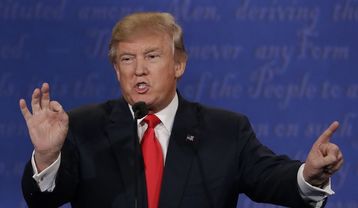
Trump's success brings up questions about the role of the quality of persuasive language particularly in a debate setting. How necessary is traditional logic and argumentative skill in this debate? Here, verbal persuasion relies more on quantity than quality. Repetition and salience capture our attention. Perhaps, in a rapidly paced interactional context, quantity and tone drive communication more than quality. Momentary success, in this debate, is defined as the ability to speak uninterrupted (Thomas, 2016). Quantity, rather than quality, defines linguistic power and effectiveness in combative speech interactions.
2 the last debate. You were both asked about the situation in the Syrian city of
3 Aleppo, and I want to follow up on that ((Camera split screen on Trump and
4 Clinton)) because you said several things in that debate which were not true, sir.
5 You said that Aleppo has basically fallen, in fact there are…
6 Trump: ((Trump Shrugs)) It’s a catastrophe.
7 W: It is a catastrophe, but there-
8 T: It’s a mess
9 W: There are a quarter-
10 T: Have you seen it? Have you seen it?
11 W: Sir-
12 T: Have you seen what’s happened to Aleppo?
13 W: Sir, if I may finish my questions,
14 T: ((Uses mocking tone)) Okay, so it hasn’t fallen. Take a look at it.
15 W: Well there are a quarter of a million people still living there and being
16 slaughtered ((raises voice volume slightly)).
17 T: That’s right.
18 W: You also said-
19 T: And they are being slaughtered.
20 W: Yes.
21 T: Because of bad decisions. ((Points at Clinton))
22 ((Clinton widens eyes; raises eyebrows)
This cumulative effect is salient each time Wallace attempts to halt Trump’s statements. For example, Wallace interjects terms such as “but” (Line 7) and “Sir” (Lines 11 and 13), to attempt to silence Trump. While these direct challenges briefly hinder Trump, the staccato-ed nature of his statements keep them from disrupting argumentative meaning. Quick comments keep semantic material intact, reducing the effect of interruptive verbal challenge. Therefore, in this almost-combative debate environment, basic language conveys communicative information more efficiently than substantive, logical prose.
Furthermore, utilizing constant questioning, Trump is able to control the debate discourse. In a debate, it is accepted that a moderator will be the only one to ask questions and the candidates will respond accordingly. However, Trump often appears to use pointed questions to direct attention from his own ignorance. Asking repetitively “Have you seen it” (Line 10) and “Have you seen what’s happened to Aleppo?” (Line 12) to Wallace, Trump alters the expected nature of moderator-candidate interaction by not only interrupting Wallace, but doing so in a way that literally steals his words as moderator (Fairclough, 1989).
Ultimately, Trump’s questioning style causes Wallace to cede his own power. In a statement made before the debate, Wallace states, “If [a moderator] succeeds, when it’s over, people will say ‘You did a great job. I don’t ever remember you ever even being on the stage’” (Luibrand, 2016). To Wallace, a moderator’s power comes from their ability to discretely guide conversation. Trump’s rapid firing of questions directly at Wallace derails this very definition of power.
Wallace responds to Trump’s questions: “Well there are a quarter of a million people still living there and being slaughtered” (Line 15). Although his voice is raised and his statement is true, indicating an awareness and offensiveness, in responding to the posed question, Wallace deviates from his self-defined role by inserting himself directly into the debate, indicating an accidental cessation of power. Here, Trump combines the expected form of powerful language with his own style of intense repetition. This combination characterizes the capacity of a Trump’s combative speaking style to overwhelm or distort set power structure even in the face of oppositional hard fact.
Utilizing the effects of rapid, repetitive interjections combined with aggressive vocal tone and pugilistic gestures, Trump routinely successfully derails his opponents’ ability to rally the American public in a debate setting. While this combative style of speaking is prevalent in many confrontational interactions, the magnitude of its success in a widespread political context is unsurpassed. At this point in the election, we wonder just how far this behavioral style may carry Trump. While his repertoire consistently results in transient success, the patterns have yet to result in a sustained control over the direction and tone of the election for the masses. Ultimately, while this communicative style has fueled much of his success to date, the overt lack of substance is unlikely to sustain his ultimate election to the Presidency.
Works Cited
- [CBS News]. (2016, October 19). Watch Live: The Final Presidential Debate. [Video File]. Retrieved from https://www.youtube.com/watch?v=ye0Xblp_Nb0
- Fairclough, N. (1989). Language and power. London: Longman.
- Luibrand, S. (2016, October 19). Chris Wallace: Five facts about the final presidential debate moderator. Retrieved October 24, 2016, from http://www.cbsnews.com/news/who-is-chris-wallace-5-things-to-know-about-fox-news-presidential-debate-moderator/
- Thomas, J. (2016, October 18). Lecture.
Amanda is a student in the introductory sociolinguistics course at Swarthmore College.
 RSS Feed
RSS Feed